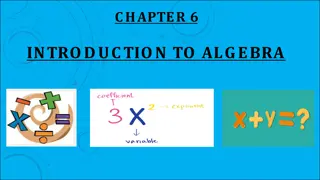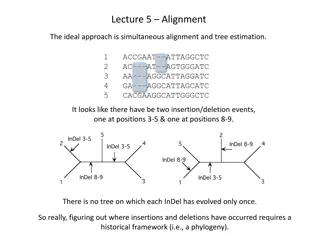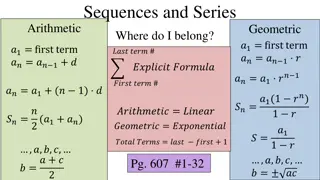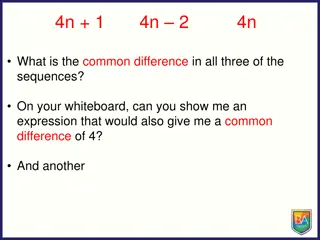Understanding Sequences and Series in Algebra 2
Dive into the concept of sequences and series in Algebra 2 with examples and diagrams from the Big Ideas Algebra 2 textbook by Larson, R., and Boswell (2022). Explore the progression of values and patterns in sequences, and learn about the sum of series to enhance your understanding of this fundamental algebraic concept.
Download Presentation

Please find below an Image/Link to download the presentation.
The content on the website is provided AS IS for your information and personal use only. It may not be sold, licensed, or shared on other websites without obtaining consent from the author. Download presentation by click this link. If you encounter any issues during the download, it is possible that the publisher has removed the file from their server.
E N D
Presentation Transcript
Sequences and Series Algebra 2 Chapter 11 1
This Slideshow was developed to accompany the textbook Big Ideas Algebra 2 By Larson, R., Boswell 2022 K12 (National Geographic/Cengage) Some examples and diagrams are taken from the textbook. Slides created by Richard Wright, Andrews Academy rwright@andrews.edu
11.1A Defining and Using Sequences After this lesson I can use rules to write terms of sequences. I can write rules for sequences. 3
11.1A Defining and Using Sequences Work with a partner. a. For each pattern, find the number of objects in each figure. Then find the number of objects in the next figure. Explain your reasoning. 4
11.1A Defining and Using Sequences Sequence Function whose domain are integers List of numbers that follow a rule Rule ??= 2? Domain: (n) Term s location (1st, 2nd, 3rd ) Range: (an) Term s value (2, 4, 6, 8 ) 2, 4, 6, 8, 10 Finite 2, 4, 6, 8, 10, Infinite
11.1A Defining and Using Sequences Write the first four terms of ??=1 Try 600#5 ?(?) = 4? 1 2? 3 6
11.1A Defining and Using Sequences Writing rules for sequences Look for patterns Guess-and-check For fractions, do top and bottom separately 2 5, Try 600#13 3.1, 3.8, 4.5, 5.2, 2 25, 2 2 125, 625,
11.1A Defining and Using Sequences To graph n is like x; an is like y The graph will be dots Do NOT connect the dots 35 30 25 20 15 10 5 0 0 1 2 3 4 5 6
11.1B Defining and Using Series After this lesson I can write and find sums of series. 9
11.1B Defining and Using Series Series Sum of a sequence 2, 4, 6, 8, sequence 2 + 4 + 6 + 8 + series
11.1B Defining and Using Series Summation Notation (Sigma Notation) Finite Upperlimit 4 2 + 4 + 6 + 8 = 2? Lowerlimit ?=1 Infinite Index of summation (variable) 2 + 4 + 6 + 8 + = 2? ?=1
11.1B Defining and Using Series Write as a summation 4 + 8 + 12 + + 100 Try 600#25 7 + 10 + 13 + 16 + 19
11.1B Defining and Using Series Find the sum of the series 10 ?2+ 1 Try 600#39 8 2 ? ?=5 ?=2
11.1B Defining and Using Series Some shortcut formulas ? 1 = ? ?=1 ? =? ? + 1 ? 2 ?=1 ? ?2=? ? + 1 2? + 1 6 ?=1
11.1B Defining and Using Series Find the sum of the series 10 3?2+ 2 Try 600#43 25 ? ?=1 ?=10
11.2 Analyzing Arithmetic Sequences and Series After this lesson I can identify arithmetic sequences. I can write rules for arithmetic sequences. I can find sums of finite arithmetic series. 16
11.2 Analyzing Arithmetic Sequences and Series Work with a partner. When German mathematician Carl Friedrich Gauss (1777 1855) was young, one of his teachers asked him to find the sum of the whole numbers from 1 through 100. To the astonishment of his teacher, Gauss came up with the answer after only a few moments. Here is what Gauss did: 1 + 2 + 3 + + 100 100 + 99 + 98 + + 1 101 + 101 + 101 + + 101 100 101 2 a. Explain Gauss s thought process. Then write a formula for the sum Snof the first n terms of an arithmetic sequence. = 5050 17
11.2 Analyzing Arithmetic Sequences and Series Arithmetic Sequences Common difference (d) between successive terms Add the same number each time 3, 6, 9, 12, 15, d = 3 Is it arithmetic? 10, 6, 2, 0, 2, 6, 10, Try 608#1 1, 1, 3, 5, 7,
11.2 Analyzing Arithmetic Sequences and Series Formula for nth term ??= ?1+ (? 1)? Linear Try 608#13 51, 48, 45, 42, Write a rule for the nth term 32, 47, 62, 77,
11.2 Analyzing Arithmetic Sequences and Series One term of an arithmetic sequence is a8 = 50. The common difference is 0.25. Write the rule for the nth term. Try 608#21 ?11= 43,? = 5
11.2 Analyzing Arithmetic Sequences and Series Two terms of an arithmetic sequence are a5 = 10 and a30 = 110. Write a rule for the nth term.
11.2 Analyzing Arithmetic Sequences and Series Try 608#33 Two terms of an arithmetic sequence are a8 = 12 and a16 = 22. Write a rule for the nth term.
11.2 Analyzing Arithmetic Sequences and Series Sum of a finite arithmetic series 1 + 2 + 3 + 4 + 5 + 6 + 7 + 8 + 9 + 10 Rewrite 1 + 2 + 3 + 4 + 5 10 + 9 + 8 + 7 + 6 11+11 +11+11 +11 = 5(11) = 55 Formula ??= ? ?1+?? 2
11.2 Analyzing Arithmetic Sequences and Series Consider the arithmetic series 20 + 18 + 16 + 14 + Find the sum of the first 25 terms. Try 609#41 20 2? 3 ?=1
11.2 Analyzing Arithmetic Sequences and Series You put money in a jar at the end of each week. The first week you put $2 in the jar, and each subsequent week you put $2 more than the previous week in the jar. a. Write a rule for the amount of money you put in the jar at the end of the nth week. b. How much money is in the jar after 9 weeks? 25
11.3 Analyzing Geometric Sequences and Series After this lesson I can identify geometric sequences. I can write rules for geometric sequences. I can find sums of finite geometric series. 26
11.3 Analyzing Geometric Sequences and Series Geometric Sequence Created by multiplying by a common ratio (r) Are these geometric sequences? 1, 2, 6, 24, 120, Try 616#1 96, 48, 24, 12, 6,
11.3 Analyzing Geometric Sequences and Series Formula for nth term ??= ?1 ?? 1 Exponential Try 616#13 112, 56, 28, 14, Write a rule for the nth term and find a8. 5, 2, 0.8, 0.32,
11.3 Analyzing Geometric Sequences and Series One term of a geometric sequence is a4 = 3 and r = 3. Write the rule for the nth term. Try 616#23 One term of a geometric sequence is a4= 192 and r = 4. Write the rule for the nth term.
11.3 Analyzing Geometric Sequences and Series If two terms of a geometric sequence are a2= 4 and a6= 1024, write rule for the nth term.
11.3 Analyzing Geometric Sequences and Series Try 616#35 If two terms of a geometric sequence are a2= 72 and a6 = the nth term. 1 18, write rule for
11.3 Analyzing Geometric Sequences and Series Sum of geometric series ??= ?1 Try 617#44 8 ? 1 1 ?? 1 ? 1 3 5 ?=1 Find the sum of the first 10 terms of 4 + 2 + 1 + +
11.3 Analyzing Geometric Sequences and Series You tell the Gospel to your friends. Four of your friends tell the Gospel to their friends, then four of each of their friends tells the Gospel, and so on. Find the total number of people who told the Gospel to others after the eighth round. 33
11.4 Finding Sums of Infinite Geometric Series After this lesson I can find partial sums of infinite geometric series. I can find sums of infinite geometric series. I can solve real-life problems using infinite geometric series. 34
11.4 Finding Sums of Infinite Geometric Series 1 2= 0.5 36
11.4 Finding Sums of Infinite Geometric Series 1 2= 0.5 2+1 1 4= 0.75 37
11.4 Finding Sums of Infinite Geometric Series 1 2= 0.5 2+1 2+1 1 4= 0.75 4+1 1 8= 0.875 38
11.4 Finding Sums of Infinite Geometric Series 1 2= 0.5 2+1 2+1 2+1 1 4= 0.75 4+1 4+1 1 8= 0.875 8+ 1 1 16= 0.9375 39
11.4 Finding Sums of Infinite Geometric Series 1 2= 0.5 2+1 2+1 2+1 2+1 1 4= 0.75 4+1 4+1 4+1 1 8= 0.875 8+ 8+ 1 1 16= 0.9375 16+ 1 1 1 32= 0.96875 40
11.4 Finding Sums of Infinite Geometric Series 1 2= 0.5 2+1 2+1 2+1 2+1 2+1 What happens if the pattern continues forever? 1 4= 0.75 4+1 4+1 4+1 4+1 1 8= 0.875 8+ 8+ 8+ 1 1 16= 0.9375 16+ 16+ 1 1 1 32= 0.96875 32+ 1 1 1 1 64= 0.984375 41
Find the partial sums for n = 1, 2, 3, 4, 5 and describe what happens to Sn as n increases. 1 5+ Try 623#3 4 +12 5+36 25+108 125+324 625+ 1 10+ 1 20+ 1 40+ 1 80+ 42
11.4 Finding Sums of Infinite Geometric Series Sum of an infinite geometric series ? = 1 ? ?1 | r | < 1 If | r| > 1, then no sum ( )
11.4 Finding Sums of Infinite Geometric Series Find the sum 2 0.1? 1 Try 623#9 2 +6 4+18 16+54 64+ ?=1
11.4 Finding Sums of Infinite Geometric Series A pendulum that is released and swings freely travels 100 centimeters on the first swing. On each successive swing, the pendulum travels 96% of the distance of the previous swing. What is the total distance the pendulum travels?
11.4 Finding Sums of Infinite Geometric Series Write 0.27272727 as a fraction.
11.4 Finding Sums of Infinite Geometric Series Try 623#21 Write 32.323232 as a fraction.
11.5 Using Recursive Rules with Sequences After this lesson I can write terms of recursively defi ned sequences. I can write recursive rules for sequences. I can translate between recursive rules and explicit rules. I can use recursive rules to solve real-life problems. 48
11.5 Using Recursive Rules with Sequences Explicit Rule Gives the nth term directly an = 2 + 4n Recursive Rule Each term is found by knowing the previous term a1 = 6; an = an 1 + 4
11.5 Using Recursive Rules with Sequences Write the first 5 terms ?1= 3,??= 2?? 1 1 Try 631#5 ?1= 2;??= ?? 1 2+ 1























